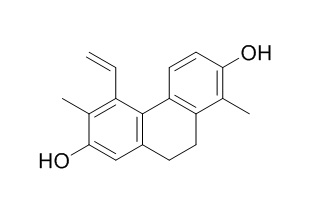Juncusol
Juncusol shows anxiolytic and sedative activities, it shows anxiolytic activity at dosages of 10 mg/kg; it can induce caspase-3-mediated cytotoxicity in HT22 cells. Juncusol has anti-microbial activity, it shows significant activity against MRSA strains.
Inquire / Order:
manager@chemfaces.com
Technical Inquiries:
service@chemfaces.com
Tel:
+86-27-84237783
Fax:
+86-27-84254680
Address:
1 Building, No. 83, CheCheng Rd., Wuhan Economic and Technological Development Zone, Wuhan, Hubei 430056, PRC
Providing storage is as stated on the product vial and the vial is kept tightly sealed, the product can be stored for up to
24 months(2-8C).
Wherever possible, you should prepare and use solutions on the same day. However, if you need to make up stock solutions in advance, we recommend that you store the solution as aliquots in tightly sealed vials at -20C. Generally, these will be useable for up to two weeks. Before use, and prior to opening the vial we recommend that you allow your product to equilibrate to room temperature for at least 1 hour.
Need more advice on solubility, usage and handling? Please email to: service@chemfaces.com
The packaging of the product may have turned upside down during transportation, resulting in the natural compounds adhering to the neck or cap of the vial. take the vial out of its packaging and gently shake to let the compounds fall to the bottom of the vial. for liquid products, centrifuge at 200-500 RPM to gather the liquid at the bottom of the vial. try to avoid loss or contamination during handling.
Toxins (Basel).2022, 14(12):824.
Oncotarget.2017, 9(3):4161-4172
Chemistry of Plant Raw Materials2019, 4:135-147
J Nat Med.2017, 71(4):745-756
Appl Biochem Biotechnol.2022, s12010-022-04166-2.
Molecules.2021, 26(4):816.
Nutrients.2024, 16(7):965.
Russian J Bioorganic Chemistry 2021, 47:1411-1417.
Mol Divers.2022, s11030-022-10586-3.
J Health Sci Med Res.2023, 31584.
Related and Featured Products
J Nat Prod. 2016 Nov 23;79(11):2814-23.
Phenanthrenes from Juncus inflexus with Antimicrobial Activity against Methicillin-Resistant Staphylococcus aureus.[Pubmed:
27808510 ]
The present study has focused on an investigation of the antibacterial effects of Juncus inflexus and the isolation and identification of its active compounds.
METHODS AND RESULTS:
Eleven phenanthrenes were isolated from a methanolic extract of the roots. Four compounds (jinflexins A-D, 1-4) are new natural products, while seven phenanthrenes [juncuenins A (5), B (6), and D (8), Juncusol (7), dehydrojuncuenins A (9) and B (11), and dehydroJuncusol (10)] were isolated for the first time from the plant. Jinflexin D (4) is a dimer with an unprecedented heptacyclic ring system. The absolute configurations of the new compounds were determined by TDDFT-ECD calculations, and their enantiomeric purity was checked by chiral HPLC analysis. Extracts of different polarity (n-hexane, dichloromethane, and ethyl acetate) were evaluated for their antimicrobial effects against methicillin-resistant Staphylococcus aureus, extended-spectrum β-lactamase (ESBL)-producing Citrobacter freundii, Escherichia coli, Enterobacter cloacae, Klebsiella pneumoniae, multiresistant Acinetobacter baumannii, and Pseudomonas aeruginosa.
CONCLUSIONS:
The MIC values of the isolated compounds were determined by a microdilution method. Jinflexin B (2), Juncusol (7), juncuenin D (8), and dehydrojuncuenin B (11) showed significant activity (MIC value range 12.5-100 μg/mL) against MRSA strains.
J Nat Med. 2015 Jul;69(3):421-6.
Chemical constituents isolated from Juncus effusus induce cytotoxicity in HT22 cells.[Pubmed:
25794817 ]
METHODS AND RESULTS:
Effususol A (1), a new 9,10-dihydrophenanthrene, has been isolated from the medullae of Juncus effusus along with ten known compounds, effusol (2), dehydroeffusol (3), Juncusol (4), dehydroJuncusol (5), juncuenin B (6), dehydrojuncuenin B (7), juncuenin D (8), luteolin (9), luteolin 5-methyl ether (10), and 4-hydroxy-2,3-dimethyl-2-nonen-4-olide (11).
CONCLUSIONS:
The structure of 1 was elucidated on the basis of spectroscopic data. 2, 4, 6, 7, and 8 have induced caspase-3-mediated cytotoxicity in HT22 cells.
Nat Prod Res. 2012;26(13):1234-9.
Phenanthrenes from Juncus effusus with anxiolytic and sedative activities.[Pubmed:
22017742 ]
Eight phenanthrenes, 7-carboxy-2-hydroxy-1-methyl-5-vinyl-phenanthrene (1); 2,7-dihydroxy-1-methyl-5-aldehyde-9,10-dihydrophenanthrene (2); dehydroeffusol (3); dehydroJuncusol (4); 7-carboxy-2-hydroxy-1-methyl-5-vinyl-9,10-dihydrophenanthrene (5); 8-carboxy-2-hydroxy-1-methyl-5-vinyl-9,10-dihydrophenanthrene (6); effusol (7) and Juncusol (8), were isolated from the aerial part of Juncus effusus.
METHODS AND RESULTS:
Compounds 1 and 2 were identified as new constituents. Compounds 7 and 8 showed anxiolytic and sedative activities.
Nat Prod Commun. 2014 Aug;9(8):1177-8.
Two new anxiolytic phenanthrenes found in the medullae of Juncus effusus.[Pubmed:
25233602]
Six phenanthrenes, 2-methoxy-7-hydroxy-1-methyl-5-vinyl phenanthrene (1), juncusin (2), dehydroeffusol (3), Juncusol (4), effusol (5), and dehydroeffusal (6), were isolated from the medullae of Juncus effusus L.
METHODS AND RESULTS:
Compounds 1 and 2 were identified as being new structures, and both of them showed anxiolytic activity at dosages of 10 and 2.5 mg/kg, respectively.



